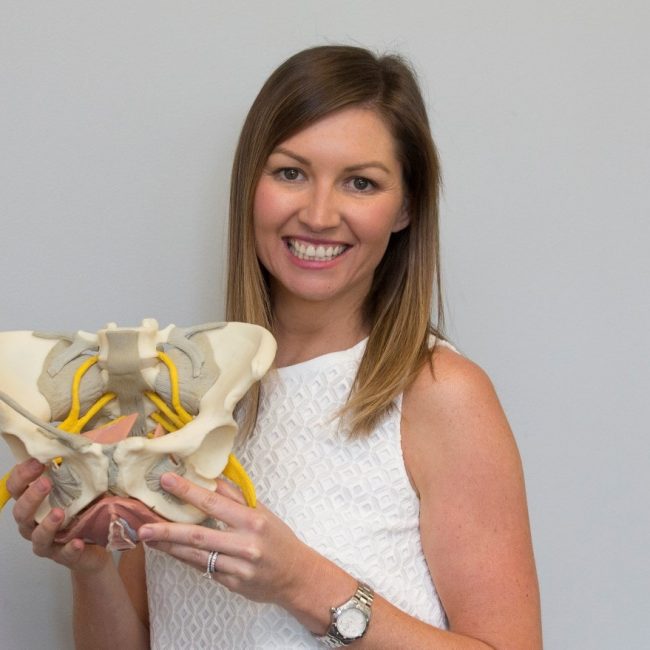
10% OFF ONLINE COURSE
Nourish your body, mind and soul.
Sign-up to receive weekly pregnancy guidance in your inbox. So that you feel calm, connected and supported throughout your pregnancy.
This week on our blog we speak to Lyz Evans, Practice Principal and Founder of Women in Focus Physiotherapy about the pelvic floor – what it is exactly, how it’s affected by birth and why it’s SO IMPORTANT to do those boring pelvic floor exercises… correctly! This is one of my favourite topics of discussion (along with birth and yoga of course!) and I think we need to open up our dialogue around caring for these precious muscles. So many of us, including me, have little idiosyncrasies in the body and getting a real-time assessment by a specialist can be so helpful.
We only get one pelvic floor – so if you learn to connect with it and prepare the muscles well prior to birth you can get through labour with so much more ease and prevent numerous complications, not just in the short term but in the long term too.
I hope you find this information useful on your journey. If you do, please share this email with other women too.
Love and gratitude,
Nadine xxx
At She Births® we recommend for women to have a pelvic floor assessment prior to birth – can you explain why this is so important? How can a women’s health physio prepare you for birth?
It is wonderful that She Births® educates its women on the importance of the pelvic floor, as for the majority of women it is not until the child bearing years that they have even heard of the pelvic floor, let alone given it much attention. To understand why it is so important to have it checked prior to birth, first we need to understand what it is and what it actually does…..
The pelvic floor is an intricate web of muscles, fascia and ligaments sitting deep within the pelvis spanning the base from the tailbone to the pubic bone. It is actually made up of 8-9 individual muscles that join together with the fascia to close off the pelvic outlet, hence creating the ‘floor’ of the pelvis. Although a relatively small muscle that is hidden from view, its importance should not be underestimated as it has some of the most critical functions in the entire body including:
• Keeping closure around the bladder to prevent urinary leaking
• Keeping closure around the rectum to prevent bowel leakage
• Providing a support system to the uterus, bladder and bowel to prevent downward descent (Pelvic Organ Prolapse)
• Provide sensation and tone required for enjoyable pain free sexual intercourse
• Provide the muscle activation to facilitate an orgasm
• Work with the deep abdominals and ‘core’ to assist with stability of the spine, hips, pelvis and rib cage
• Works with our diaphragm to ensure optimal breathing patterns
• Being able to open and fully relax at times when exiting from the pelvis is required such as when urinating, opening the bowels and of course birthing a baby!
Historically the focus for the pelvic floor has always been based around strengthening, however in recent years year’s we have realised that just like any other muscle in the body the pelvic floor has the potential to a become excessively tight (hypertonic) and this can become incredibly problematic for some women. Clinically, we are now seeing an increase in the number of women presenting with hypertonic pelvic floors and the reasons for this seem to be multifactorial in nature mainly based around lifestyle and behavior choices choices. Factors such as high level participation in exercise such as Pilates, pole dancing and weight lifting can encourage over activation of the pelvic floor, and constipation from poor dietary choices can lead to chronic straining and a pelvic floor that is always in spasm. The impact of today’s fast paced lifestyle has also lead to a pelvic floor that is constantly ‘switched on’ as a result of a lack of relaxation, diaphragmatic breathing and high anxiety and stress levels.
During birth the requirement of the pelvic floor is incredible as it needs to stretch beyond 3 times its normal length, can you imagine if you had to stretch your hamstring 3 times its normal length? It would end up at a 90-degree angle behind your head, not possible! The pelvic floor is truly a remarkable piece of anatomical engineering, however, in order for this impressive stretch to occur the muscle needs to have good flexibility and be able to completely relax during the crowning phase in birth. If a woman has a hypertonic pelvic floor that cannot fully relax or stretch, then you can imagine how this has the potential to impact or prevent achieving a normal vaginal delivery.
One of the main reasons we encourage women to have their pelvic floor checked in pregnancy, is so that we can help determine what type of pelvic floor they have, and therefore how we can best help them. If a woman has a weak pelvic floor then a specific strengthening program will be given so that the pelvic floor can continue to support the bladder, bowel and uterus throughout the pregnancy and in the post natal period.
If a woman has a hypertonic pelvic floor, then we will work with her to restore optimal breathing patterns, work manually through the vagina and pelvis to help release overly tight muscles to ‘down training’ and help restore normal mobility and length required for birth. This can be incredibly empowering and life changing for a woman who has always held tension in her pelvic floor.
Regardless of what type of pelvic floor a woman has, once in the final stages of pregnancy a Women’s Health Physio can work with her to teach her how to achieve full relaxation of the pelvic floor to achieve opening of the pelvic outlet rather than closure, which is what is required during birth.
We also recommend that women have one assessment with a chiropractor or osteopath prior to birth. How is physiotherapy different from chiropractics and osteopathy?
Chiros, Osteos and Physios all have very different training so approach the body in differing ways, in many cases we can work harmoniously together to help women achieve optimal outcomes.
The main differences when seeing a specifically trained women’s health physiotherapist is that we will do an internal check of the muscles, ligaments and organs within the vagina to check their tone and function and how this may impact the rest of the pregnancy and upcoming birth. We also utilize sophisticated real time ultrasound equipment which provides women with a visual of how their abdominals and the pelvic floor function, a wonderful way for us to educate and teach women.
Specifically trained Physios will undertake a thorough inside – outside “Pelvic Health Check” for a pregnant woman. This will usually include:
• Checking the alignment and stability of the pelvis and hips to ensure it is has symmetrical mobility required to minimize any pelvic girdle pain in pregnancy but also to prevent restriction of pelvic opening required during birth
• Assessment of the abdominal wall, rib cage and breathing patterns to address achieve optimal abdominal support and prevent excessive loads whilst the abdominal anatomy is so dramatically altered.
• Internal assessment of the pelvic floor muscles via a vaginal exam (After 12-18 weeks gestation)
• Use of real time ultrasound on the pelvic floor and abdominal muscles for feedback on activation – a wonderful teaching tool for women.
• Education on what that individual woman needs to do to optimize her pelvic floor and pelvic health for the pregnancy, birth and postnatal period.
• Prescription of a home exercise program to encourage pelvic floor and abdominal strength or relaxation.
• Discuss regular exercise habits and what is suitable for the individual.
After birth, what happens to your pelvic floor? How can you strengthen it?
A vaginal birth is essentially the biggest load that your pelvic floor will ever have placed on it, and studies show an average of 25 – 35% reduction in pelvic floor strength following birth. We also know that in 80% of women the nerve that innervates the pelvic floor (the pudendal nerve) is bruised and some times partially damaged from the birth so the messages it sends to achieve activation of the pelvic floor occurs much much slower.
As a result, more than 50% of women will experience urinary or bowel leaking in the first few weeks and months following birth, so don’t be alarmed if this occurs. If the birth was slightly more complicated requiring an episiotomy, forceps, ventouse, prolonged second stage, or a very large baby, then these women are often more likely to feel the impact to the pelvic floor in the months following birth.
The good news is for the majority of women if a specific pelvic floor program is performed daily then good pelvic floor strength and control will return. In the early days, women should reconnect with the pelvic floor on the post natal ward as this is an essential part of encouraging the pudendal nerve to regenerate and the muscles to reactivate. Starting by activating and holding gently for 1 second and repeating 5 -10 of these a few times a day is enough to get started. Timing this at that same time as feeding baby is a great way to remember to do them.
Once this becomes easy then the endurance and hold time should be increased. The term ‘use it or lose it’ definitely applies to the pelvic floor, and if you want it to be with you and support you through life then you need to give it a little love and TLC in its time of need.
How do you know if you’re doing pelvic floor exercises correctly?
Unfortunately, the answer to this question really is that you need to have it checked by a Women’s Health Physiotherapist to be 100% sure you are doing it correctly. Even the ultrasound cannot 100% confirm a correct activation and breathing patterns will come into play.
We know from research that when the general population are given instructions on how to do a pelvic floor activation that greater than 50% will do it incorrectly, of which 25% were found to be actually bearing down rather than lifting up (Eeek!) If a woman doesn’t have access to a Women’s Health Physiotherapist and wants to check herself the best way would be to insert a clean finger into the vagina, and when activating the pelvic floor she should feel a tightening and a ‘suck’ up of the finger inwards and upwards. She should be able to breathe and hold for 10 seconds without the finger being pushed out.
My advice to women is to be proactive in their childbearing years, to find yourself a good Women’s health Physiotherapist and be sure to see them at least once in pregnancy and then again at 6 weeks post natal. These appointments will potentially save your pelvic floor in the long term.
It really bugs me that women are not routinely sent for pelvic floor rehabilitation following a birth, if you were to undergo surgery for a hamstring tear you would 100% be sent by the surgeon to a Physio for months of post operative rehabilitation, why does this not happen for the pelvic floor?!
We have a long way to go in Australia and I would love us to look towards France whose government provides 6 -8 sessions of routine government funded pelvic floor Physiotherapy to help restore function post birth. Go France! Perhaps one day we will get there, but for now we either need to move to Paris or be proactive with our pelvic floors. After all you only get one of them so please make sure you look after it!
If you have any questions, you can contact Lyz Evans from Women in Focus Physiotherapy here.


Nourish your body, mind & soul during the most sacred and special time in our lives.
Sign up and receive 10% OFF the Full Online Course.Sign up to receive weekly nourishment for your body, mind & soul in your inbox. Feel calm, connected and inspired throughout your pregnancy.
We are blessed to live in this country. We offer our deep respect, acknowledgement and thanks to the traditional owners and elders past, present and future of this sacred land. We believe in climate justice and the decolonisation of birth. May we restore this planet together and restore birthing on country. May we all awaken to true healing and live in connection with country wherever we are on the planet.

10% OFF ONLINE COURSE
Nourish your body, mind and soul.
Sign-up to receive weekly pregnancy guidance in your inbox. So that you feel calm, connected and supported throughout your pregnancy.

Buy Now, Pay Later available at checkout
Add your favourites to your cart
Select Paypal at checkout

Select the Pay in 4 button. Your purchase will be split into 4 payments